|
|
 |
|
 |
| |
Publisher: Chairman Jian-Jang Huang Editors: Professor
Snow H. Tseng, Ms. Hsiao-wen Lin July 30, 2020 |
| |
|
 |
|
Due to the recent COVID-19 pandemic, all large gatherings and seminars with over 100 participants have been cancelled for the remainder of the second semester of the 108th academic year. In response to the call to help stop the spread of the virus, all following seminars were held in the form of online video conferences. |
|
|
|
April “GIPO Colloquium” Highlights |
|
|
2:20 pm,
April
10 (Fri.), 2020 |
|
Speaker: |
Prof. Tsung-Hsien Lin (Department of Photonics, National Sun Yat-sen University) |
|
Topic: |
Liquid Crystals Research/Applications Beyond Displays |
| |
|
|
|
2:20 pm,
April
17 (Fri.), 2020 |
|
Speaker: |
Prof. Meng-Tsan Tsai (Electrical Engineering Department, Chang Gung University) |
|
Topic: |
Functional Optical Coherence Tomography in Dermatology |
|
|
|
May “GIPO Colloquium” Highlights |
|
|
2:20 pm, May
1 (Fri.), 2020 |
|
Speaker: |
Prof. Wei-Chieh Tseng (Department of Chinese, National Taiwan Normal University) |
|
Topic: |
In the Name of Charity - The Origin and Darkness of Collective Unconscious of East Asia |
|
|
|
|
|
2:20 pm, May 15 (Fri.), 2020 |
|
Speaker: |
Prof. Sheng-Hao Tseng (Department of Photonics, National Cheng Kung University) |
|
Topic: |
Diffuse reflectance spectroscopy for probing in vivo skin and its applications to noninvasive diagnosis and health monitoring |
|
|
|
|
|
2:20 pm, May 22 (Fri.), 2020 |
|
Speaker: |
Prof. Li-Yin Chen (Department of Photonics, National Chiao Tung University) |
|
Topic: |
Simple-structured organic light-emitting diodes for lighting |
| |
|
|
|
2:20 pm, May 29 (Fri.), 2020 |
|
Speaker: |
Prof. Hsiao-wen Zan (Department of Photonics, National Chiao Tung University) |
|
Topic: |
Applications of Novel Semiconductor Components and Systems in Biomedical Imaging and Detection |
|
|
|
June “GIPO Colloquium” Highlights |
|
|
2:20
pm, June 5 (Fri.), 2020 |
|
Speaker: |
Prof. You-Chia Chang (Department of Photonics, National Chiao Tung University) |
|
Topic: |
Scalable low-power silicon photonic platform for all-solid-state beam steering |
|
|
|
|
|
2:20
pm, June 12 (Fri.), 2020 |
|
Speaker: |
Prof. Cheng-Ling Lee (Department of Electro Optical Engineering, National United University) |
|
Topic: |
Ultracompact fiber interferometers |
|
|
|
|
 |
|
 |
|
| |
|
 |
Depth Camera Using Off-Axis Dual Electro-Optical Irises
Professor Jui-che Tsai
Graduate
Institute of Photonics and
Optoelectronics, National Taiwan
University
We have developed a depth camera prototype with off-axis dual electro-optical (DEO) irises. Our DEO irises are switchable through the polymer dispersed liquid crystal, and exhibit the advantages of low cost, easy fabrication, and higher transmittance compared to the traditional liquid crystal shutters. The transmittance of our device is near 75% when the driving voltage amplitude reaches about 30 V. The principle of depth measurement of our system is based on a pair of stereo images, which are captured through the left and right irises, respectively. The depth is calculated from the shifts of features between the two images.
© 2019 IEEE
H. H. Chen, Y. X. Lai, W. C. Lee, and J. C.
Tsai, “Depth camera using high-transmittance
off-axis dual electro-optical irises,”
IEEE Photonics Journal,
Vol. 11, No. 5, 6901607, Oct. 2019.
Application of localization landscape theory and the k•p model for direct modeling of carrier transport in a type II superlattice InAs/InAsSb photoconductor system
Professor Yuh-Renn Wu
Graduate
Institute of Photonics and
Optoelectronics, National Taiwan
University
Localization landscape (LL) theory is applied to directly model carrier transport in a type II superlattice (T2SL) InAs/InAsSb photoconductor system. It is difficult to apply the classical Poisson and drift–diffusion (DD) model to direct modeling of carrier transport in superlattice systems because quantum effects need to be considered. With LL theory, it is possible to obtain the effective quantum potential seen by carriers. By coupling LL theory with the Poisson– DD model and replacing the traditional conduction and valence potentials with effective quantum potentials, it is possible to directly model carrier transport in a T2SL system. We compare the results of this approach with experimental results and find very good agreement, which indicates that this method will provide an efficient tool for T2SL design.
|
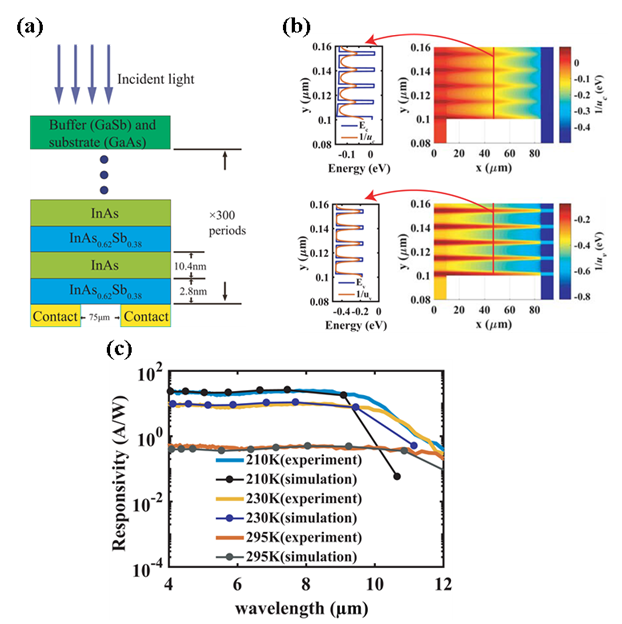
|
|
Fig. 1.(a) The structure of the photodetector. (b) Comparison of LL+Poisson–DD solver and Poisson–DD solver with bias of 0.5 V. (c) Responsivities at 210 K, 230 K, and 295 K. |
Optical Responses and Chirps of Transistor Lasers
Professor Chao-Hsin Wu
Graduate
Institute of Photonics and
Optoelectronics, National Taiwan
University
Transistor laser (TL) is a novel three-port dual electrical and optical transmitter based on heterojunction bipolar transistor (HBT). Reversed bias in the BC junction causing Franz-Keldysh (F-K) effect acts as the internal electro-absorption modulator which is also called the intracavity photon-assisted tunneling (ICPAT). Therefore, transistor lasers can be modulated by both base current injection and the voltage of BC junction. We study the frequency responses of the base current modulation and BC voltage modulation of TLs by introducing the ICPAT into laser rate equations. Furthermore, we modify the small-signal model of HBT with the addition current caused by the F-K absorption (Fig. 1(a)). Then, we simulate the optical frequency responses [J. Appl. Phys. 125, 023105 (2019)]. Beside the amplitude modulation, chirp is also important in the optical communication of lasers. We study the small-signal chirping of the voltage modulation of TLs which is different from the diode laser. The frequency shift of the Gaussian pulse is neither positive nor negative chirp. Thus, the pulse can be compressed regardless of dispersion type of the fiber [Opt. Lett. 44, 2109 (2019)].
|
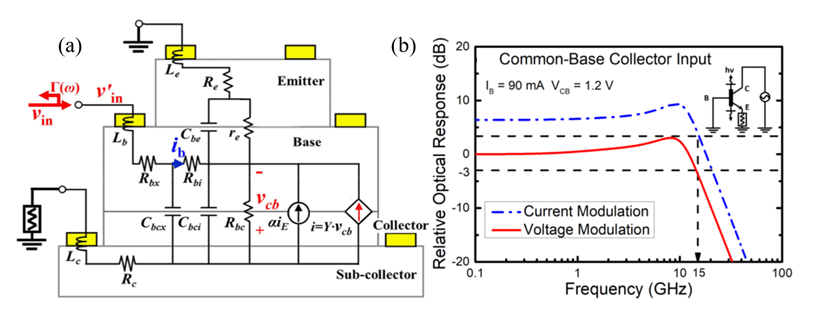
|
|
Fig. 1.
(a) The small-signal T model of transistor lasers (b) The optical frequency responses under common-base collector input. |
|
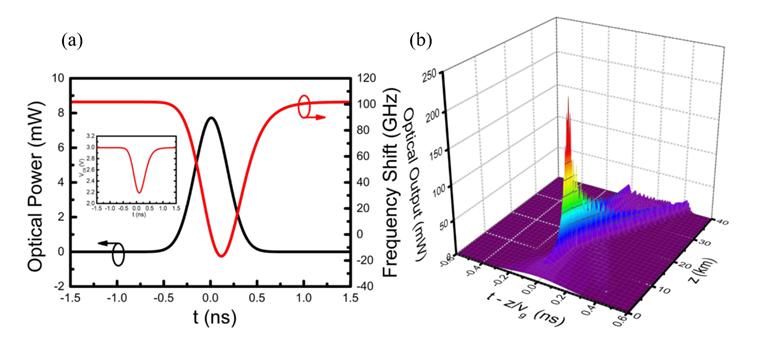
|
|
Fig. 2. (a) Chirp of the Gaussian pulse from TL (b) Pulse compression in the fiber. |
Development of fast-response VA-FFS liquid crystal mode for VR/AR applications
Professor Wing-Kit Choi
Graduate Institute of Photonics and
Optoelectronics, National Taiwan University
We have recently proposed to use new and novel 3D electrode design to improve the performance of VA-FFS liquid crystal (LC) mode, which has been actively developed for VR/AR applications in recent years [1-2]. By using 3D design, we have found that it could help improve the potential transmission, response speed and stability in these VA-FFS LC devices as a result of newly generated electric field profiles in the LC layer and having more “virtual walls” surrounding an LC domain. Recently, we have further investigated the effects of positive and negative LC dielectric anisotropy. We found that positive can have faster response time whereas negative LC can have higher transmission. We also found that negative LC can have a much more complicated switching mechanism and less stable “virtual walls” compared to the positive LC and hence resulted in slower response time. By using our new 3D electrode, we found that it could help bring the response time of negative LC closer to that of positive LC as a result of having more symmetrical electric fields generated. All these new findings and discoveries can help the future development of VR/AR which requires very fast response time of LC and have recently been reported in
Optics
Express [1].
The concept of “virtual walls” or “self-imposed boundaries” in VA-FFS LC, which is originated from W.K. Choi and S.T. Wu’s US Patent [3], has been actively employed by academics and industries (e.g. JDI and SHARP, Japan) for developing their latest fast-response LC devices for VR/AR technology in recent years [1].
[1] Wing-Kit Choi, Chih-Wei Hsu, Chia Hsiang Tung and Bo-Kai Tseng, “Effects of electrode structure and dielectric anisotropy on the performance of VA-FFS LC mode,”
Optics
Express,vol.27, No.23, pp.34343-34358, Nov. (2019)
[2]
Wing-Kit Choi, Chia-Hsiang Tung and
Bo-Kai Tseng, “Fast-Response VA-FFS liquid crystal mode using 3D electrode
design”
Display week - SID
Digest, vol. 48, Issue 1, pp 1838–1840 (2017)
[3] Wing-Kit Choi and Shin-Tson Wu, “Fast response liquid crystal mode” US Patent 7298445 B1 (2007)
|
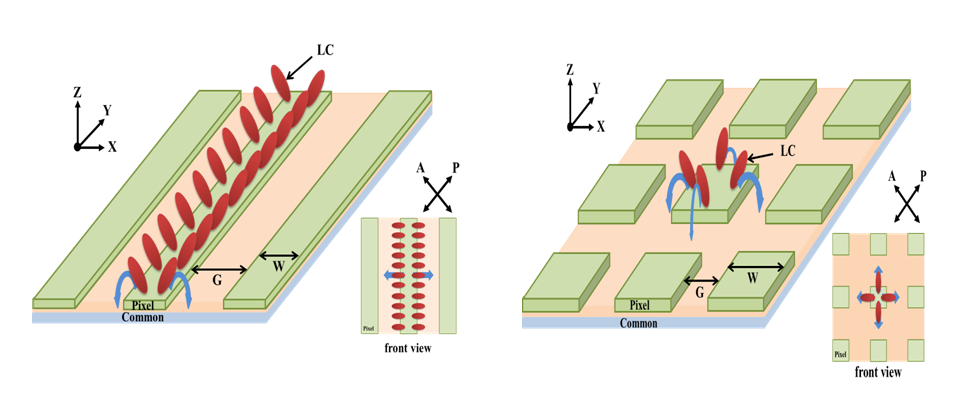
|
|
Fig. 1.
Electrode structure of (a) 2D VA-FFS LC and (b) 3D VA-FFS LC at voltage-on state |
|
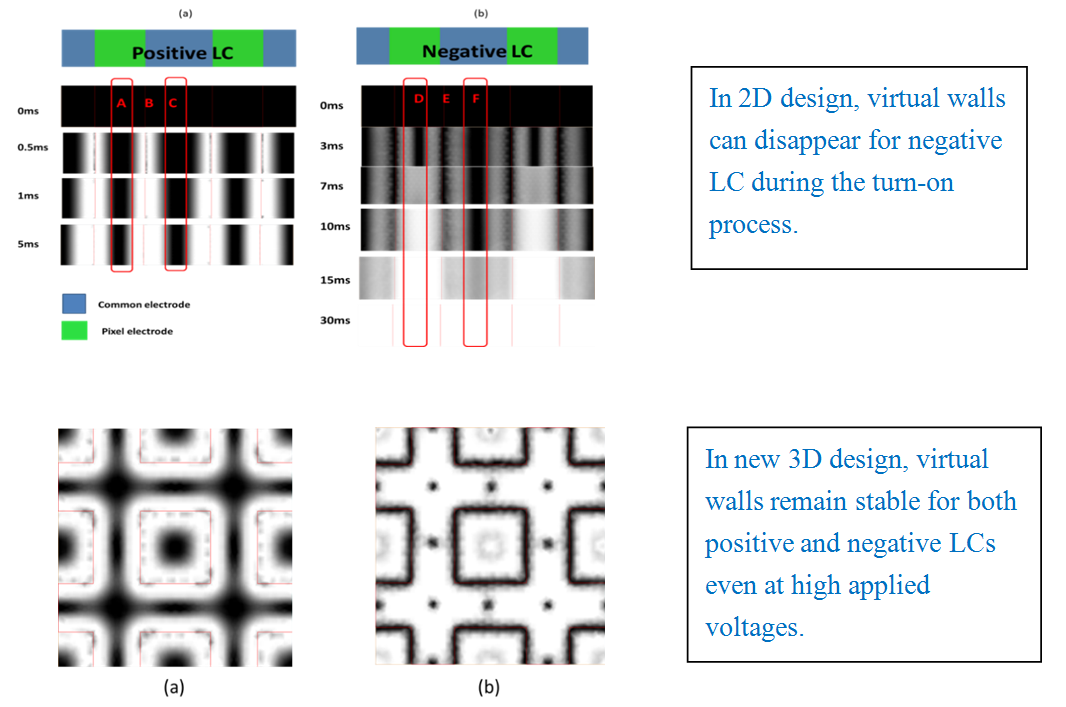
|
|
Fig.2. Comparison of turn-on process and top-view profiles between (a) positive and (b) negative LC with 2D and 3D electrode. Note that with negative LC in 2D it takes longer time to turn on (become brighter). |
|

|
|
Fig. 3. The LC direction distribution profiles at ON-state for (a) positive and (b) negative LC in 3D electrode design. Circled regions correspond to the disclinations or “virtual walls” regions. |
Quantitative
Blood Flow Imaging with Optical Coherence
Tomography Angiography
Professor Hsiang-Chieh
Lee
Graduate
Institute of Photonics and
Optoelectronics, National Taiwan
University
Optical Coherence Tomography (OCT) provides real-time and cross-sectional images of
in
vivo
tissue architectural information without requiring exogenous contrast agents. Recently, the functional extension of OCT technology has been an emerging research topic, promising to further boost various medical applications with OCT. Particularly, studies have demonstrated the use of either optical micro-angiography (OMAG) or OCT angiography (OCTA) technique to identify the subsurface volumetric microvascular information of the biological tissues
in
vivo by measuring the variation of the intensity or the phase of the OCT signals between neighboring A-scans or B-scans of the structural OCT images. Due the flowing nature of the red blood cells with the microvascular network, it results in the variations of the OCT signal aforementioned when compared to the static scattering characteristic of the surrounding tissues. When compared to microvascular imaging techniques, for example, fluorescence angiography with the indocyanine green (ICG), OCTA, or OMAG exhibit several advantages, including high imaging contrast, free of exogenous contrast agents, high temporal and spatial imaging resolution. However, it has been challenging to provide blood flow information in the OCTA images.
Therefore, our group has developed and implemented the variable interscan time analysis (VISTA) algorithm to provide the relative blood flow information on the OCTA images generated. Also, in order to perform more comprehensive hemodynamic information of the imaged tissue, we have developed an OCT instrument allowing OCT and OCTA images of the mouse ear skin model with two different A-scan or axial (depth) scan speeds, 100 kHz and 200 kHz. Figure 1 shows the projected
en face
OCTA images of the mouse ear skin with an effective interscan time of 12.5 milliseconds (ms) and 25 ms by using the swept source laser either with an A-scan rate of 100 kHz or 200 kHz. The longer effective interscan time, the more blood vessels are identified, as marked by orange arrows in Fig. 1(a) and Fig. 1(b). The OCT system with a higher detection sensitivity with a lower speed swept source laser is sensitive to detect tiny signals marked by the red arrows shown in Fig. 1(a) compared with Fig. 1(c). Fig. 1(d) shows a color-coded OCTA image where red and blue color indicates blood flow with a relatively high and slow flow speed, respectively, by using the VISTA algorithm and scanning protocol.
|
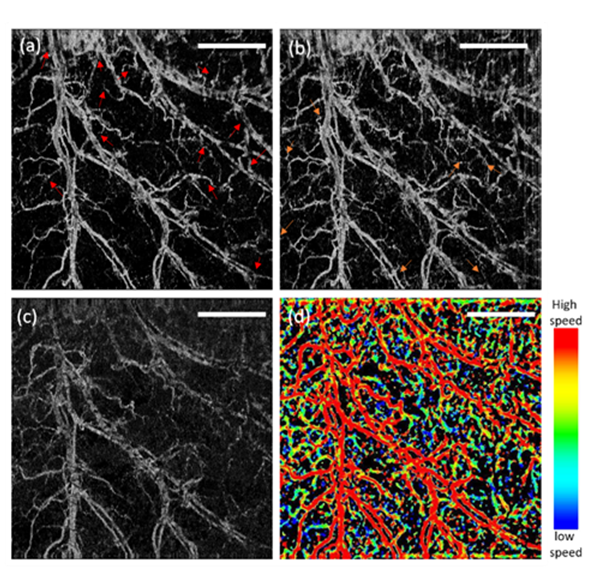
|
|
Fig. 1.En face OCTA image of the mouse ear skin with (a) 12.5 ms, (b) 25 ms by 100 kHz swept-source laser, and (c) 12.5 ms by 200 kHz swept-source laser, (d) color-coded OCTA image with 12.5 ms and 25 ms by 200 kHz swept-source laser. Colors in speed: high-speed blood flow, red; intermediate speed blood flow, green, low-speed blood flow, blue. Scale bar: 1 mm |
|
|
|
 |
|
 |
|
| |
|
|
 |
|
 |
|
|
|